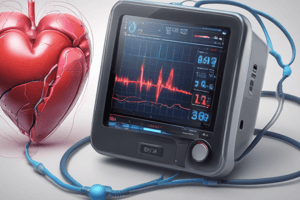Podcast
Questions and Answers
What is the primary purpose of Ambulatory ECG monitoring?
What is the primary purpose of Ambulatory ECG monitoring?
- To analyze ventricular function
- To measure electrical potential amplitude
- To monitor cardiac vector direction
- To detect abnormal rhythms and ischemic episodes (correct)
What does the length of the arrow represent in cardiac vector analysis?
What does the length of the arrow represent in cardiac vector analysis?
- Magnitude of the electrical potential (correct)
- Duration of the cardiac cycle
- Direction of electrical potential
- Speed of current flow
What is the direction of electrical potential travel through the interventricular septum?
What is the direction of electrical potential travel through the interventricular septum?
- From the base of ventricles towards the apex (correct)
- Through the outer surface of the heart
- Through the inner surface of ventricles
- From the apex towards the base of ventricles
What is the term for the mean direction of flow of electrical potential at one instance?
What is the term for the mean direction of flow of electrical potential at one instance?
What is the duration of recording in Ambulatory ECG monitoring?
What is the duration of recording in Ambulatory ECG monitoring?
What is the primary location of the electrical potential that travels downwards through the outer surface of the heart?
What is the primary location of the electrical potential that travels downwards through the outer surface of the heart?
What is the direction of the mean flow of electrical potential in the heart?
What is the direction of the mean flow of electrical potential in the heart?
What is the term for an irregular heartbeat or disturbance in the rhythm of the heart?
What is the term for an irregular heartbeat or disturbance in the rhythm of the heart?
What is the type of arrhythmia in which the SA node is the pacemaker?
What is the type of arrhythmia in which the SA node is the pacemaker?
What is the device surgically implanted to regulate abnormal heartbeat?
What is the device surgically implanted to regulate abnormal heartbeat?
What is the sequence of coordinated events taking place in the heart during each beat?
What is the sequence of coordinated events taking place in the heart during each beat?
What is the term for the structure that becomes the pacemaker in ectopic arrhythmia?
What is the term for the structure that becomes the pacemaker in ectopic arrhythmia?
What is the primary indication for recording an electrocardiogram (ECG) during graded physical activity?
What is the primary indication for recording an electrocardiogram (ECG) during graded physical activity?
What is the significance of a failure to achieve a desired increase in blood pressure during an exercise ECG test?
What is the significance of a failure to achieve a desired increase in blood pressure during an exercise ECG test?
What is the primary purpose of ambulatory ECG monitoring?
What is the primary purpose of ambulatory ECG monitoring?
What is the term for the changes in the ST segment of an ECG that confirm the presence of ischemia?
What is the term for the changes in the ST segment of an ECG that confirm the presence of ischemia?
What is the primary factor controlling cardiac output?
What is the primary factor controlling cardiac output?
What is the term for the recording of an ECG during daily activities?
What is the term for the recording of an ECG during daily activities?
Flashcards are hidden until you start studying
Study Notes
- In the heart, the electrical potential flowing downwards from base to apex is greater in magnitude than in other directions, resulting in a downward mean direction of flow.
- This downward vector is called the instantaneous mean vector or instantaneous summated vector at a given instance.
- Arrhythmia refers to irregular heartbeat or disturbance in the rhythm of the heart, which can occur in physiological and pathological conditions.
- Normotopic arrhythmia is an irregular heartbeat where the SA node is the pacemaker, while ectopic arrhythmia is an abnormal heartbeat where another structure of the heart becomes the pacemaker.
- Artificial pacemakers are small electronic devices implanted to regulate abnormal heartbeat, containing a battery-powered pulse generator that produces electrical impulses to stimulate the heart.
- Cardiac cycle is defined as the succession of coordinated events taking place in the heart during each beat.
- Ambulatory ECG (Holter Monitoring) records ECG from one or more leads continuously for 24-48 hours, helping detect abnormal rhythms and episodes of ischemia or arrhythmia.
- Cardiac vector represents the direction of electrical potential generated in the heart at an instant, with the length of the arrow representing the amplitude or voltage of the potential.
- When current flows through the interventricular septum, electrical potential travels in different directions, including downwards through the septum, upwards through the inner surface of ventricles, and downwards through the outer surface of the heart.
- The electrocardiogram (ECG) is used to monitor cardiac activity, with bipolar leads, unipolar leads, and normal ECG patterns.
- Cardiac arrhythmias can involve normal cardiac rate, abnormal pacemakers, implanted pacemakers, and ectopic excitation.
- The heart's mechanical events include late diastole, atrial systole, ventricular systole, and early diastole, with cardiac output affected by factors such as tension, length, and contractility.
- Electrocardiogram is used in applied physiology to detect ischemia, with changes in stress ECG recording providing evidence for ischemia of cardiac muscle.
Studying That Suits You
Use AI to generate personalized quizzes and flashcards to suit your learning preferences.




